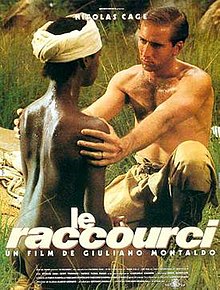Time to Kill (1989 film)
| Time to Kill | |
|---|---|
 French poster | |
| Directed by | Giuliano Montaldo |
| Screenplay by | Furio Scarpelli Paolo Virzì Giacomo Scarpelli Giuliano Montaldo |
| Based on | Time to Kill by Ennio Flaiano |
| Produced by | Leo Pescarolo Guido De Laurentiis |
| Starring | Nicolas Cage Ricky Tognazzi Giancarlo Giannini |
| Cinematography | Blasco Giurato |
| Edited by | Alfredo Muschietti |
| Music by | Ennio Morricone |
Production companies | Reteitalia DMV Distribuzione Ellepi Film Italfrance Dania Film |
| Distributed by | Titanus (Italy) Metro-Goldwyn-Mayer (France)[1] |
Release dates |
|
Running time | 110 minutes |
| Countries | Italy France |
| Language | English |
Time to Kill (Italian: Tempo di uccidere) is a 1989 Italian historical drama film starring Nicolas Cage, and Italian actors Ricky Tognazzi and Giancarlo Giannini. It is directed by Giuliano Montaldo. The film is set in 1936, when Ethiopia was under Italian invasion, and was filmed in Zimbabwe.[2][3] It is based on the novel with the same name written by Ennio Flaiano.[4]
Plot
[edit]Lieutenant Silvestri suffers a toothache and decides to head to the a camp hospital at a nearby construction site. En route to the camp his vehicle has an accident and stops near a rock; Silvestri continues by walking, but no physician is found at the construction site. He is directed by a young man on an allegedly shorter route to the main camp, and on his way through the jungle he meets and rapes a young Ethiopian woman. She stays with him afterwards and he gives her his watch as a present. While they take refuge in a cave Silvestri shoots at a hyena, but the bullet ricochets and hits the woman. He buries her, trying to hide all traces, observing some Ethiopian people arriving nearby. Silvestri continues to the dentist at the main camp, where he tells the story to his superior, who decides to do nothing.
Later his unit kills people in retribution for attacks by insurgents in the area where he recognizes among the dead various civilians he observed the previous day. He also meets Elias, wearing Silvestri's pants (which he seems to have forgotten at the site), and Johannes, Elias' father.
He finally receives news that he has been granted a furlough, but while celebrating with his friend and a superior officer he learns that the white turban of the girl means she was leprous. This and a festering wound on his hand lead him to believe he has leprosy. He seeks out a doctor with the cover story of researching for a book. The doctor explains to him all the signs of lepra, which convinces and horrifies him even more. When the doctor insists on examining his hand, he gives the doctor a false name, and even shoots at him, before boarding the ship to Italy.
As he tries to return to his wife in Italy, Silvestri evades and even steals from his former and finally hides at the father of the girl, Johannes. After he lives through a real or imagined illness, Johannes explains to him that Mariam wasn't ill, and in exchange he tells her father how she really died, leading him to the burial site.
The movie switches back to the actual history of Ethiopia for some moments and Silvestri's former friend tells the aftermath.
Cast
[edit]- Nicolas Cage as Lt. Enrico Silvestri
- Ricky Tognazzi as Mario
- Giancarlo Giannini as Major (Cesare)
- Patrice Flora Praxo as Mariam
- Gianluca Favilla as Army Driver
- Georges Claisse as Dr. Tiberi
- Robert Liensol as Joannes
References
[edit]- ^ "Time to Kill (1991)". UniFrance. Retrieved 22 February 2023.
- ^ "Tempo di uccidere". MyMovies. Retrieved 28 November 2011.
- ^ Liliana Ellena. Film d'Africa. Archivio nazionale cinematografico della Resistenza, 1999.
- ^ Fabrizio Natalini (2005). Ennio Flaiano: una vita nel cinema. Artemide, 2005. ISBN 88-7575-017-3.
